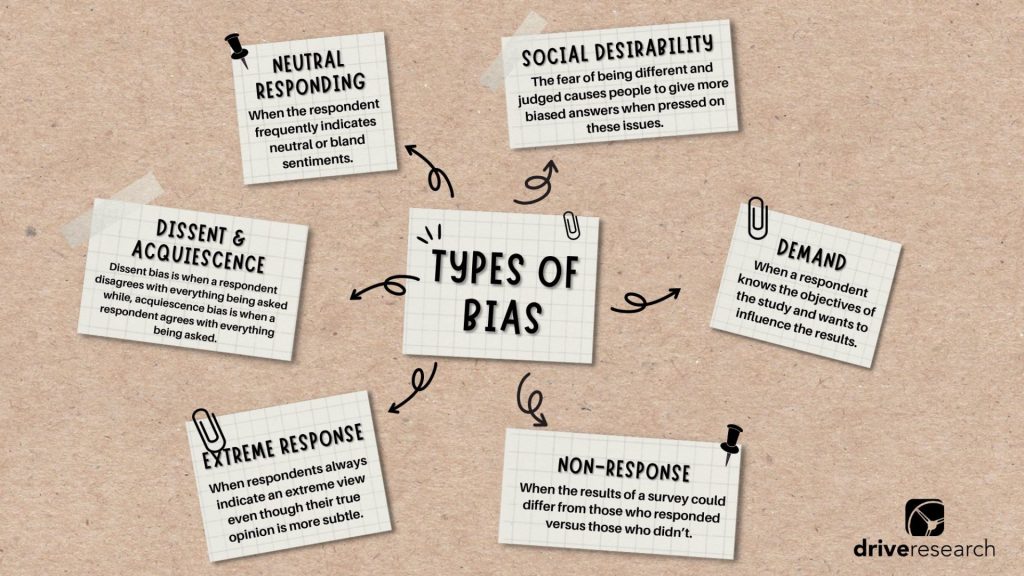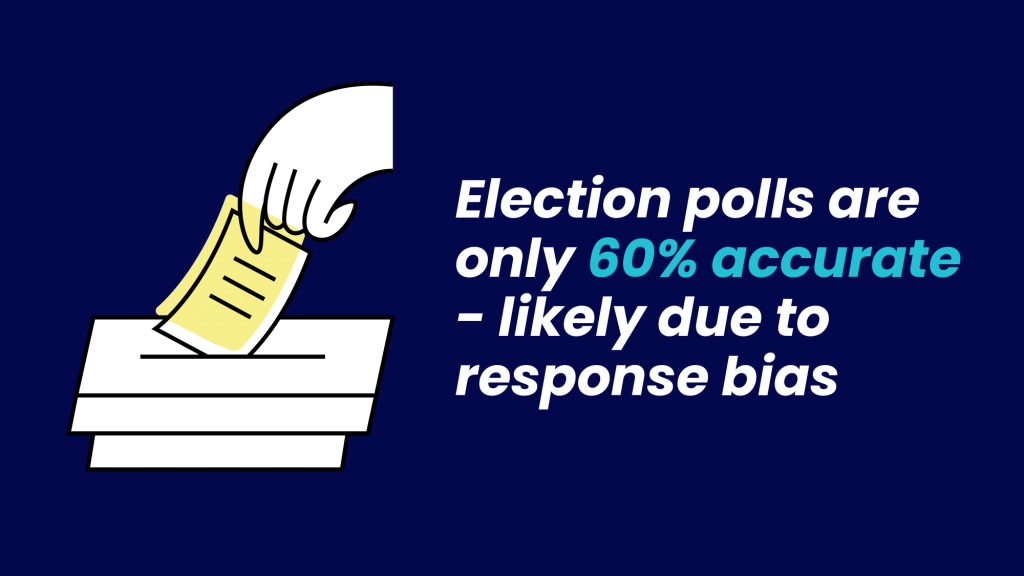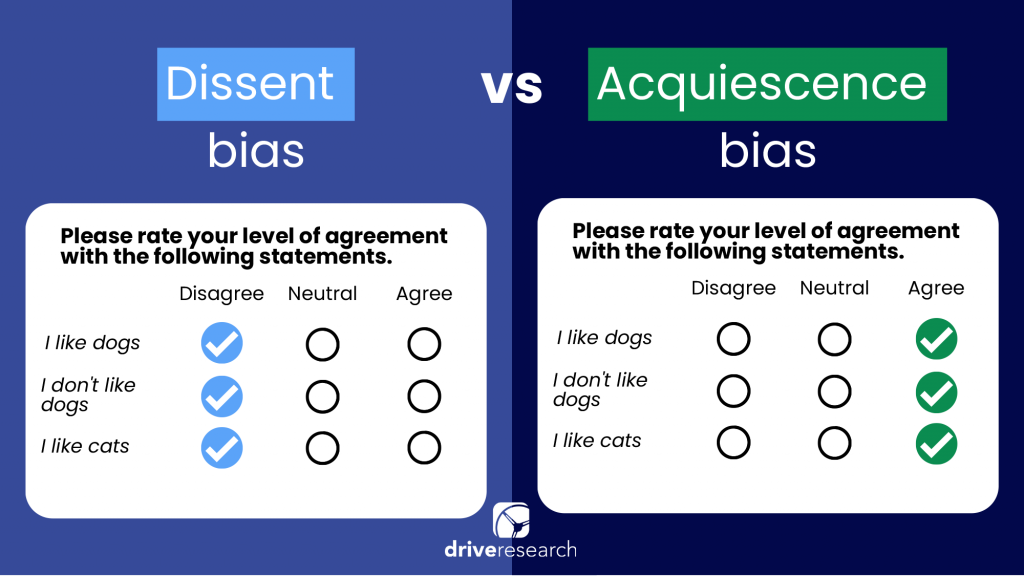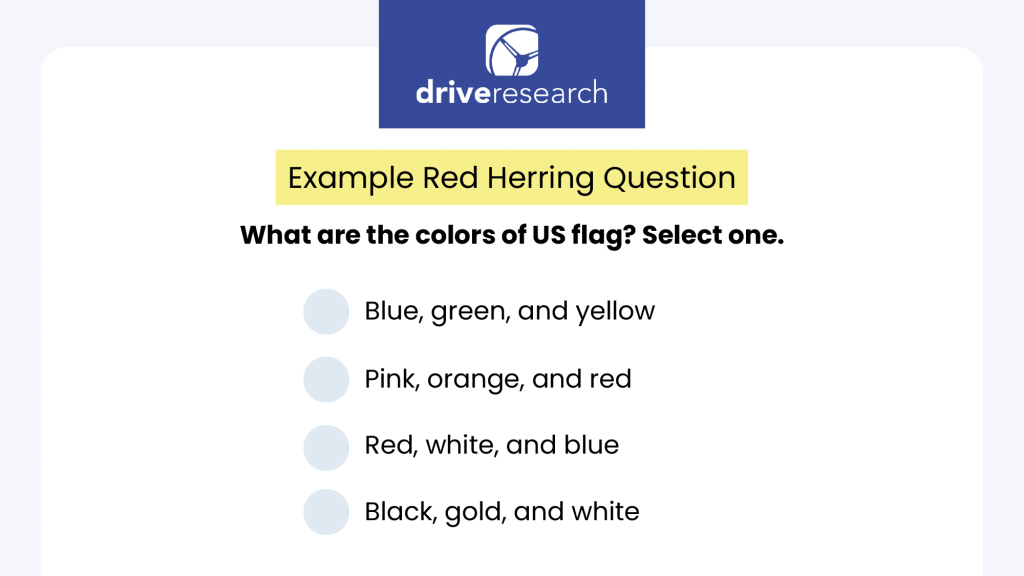
Bias exists everywhere and it can affect anything and anyone.
It impacts many things such as, how we view others, make decisions, or live our lives.
It’s why response bias is extremely common in market research.
The researcher and respondent each have a role to play to ensure honest data collection.
Let’s discuss what response bias is, different types of bias in market research, and how it can be avoided.
Response Bias: Definition
Generally speaking, response bias in market research is when people do not provide honest answers to questions asked in a study.
Now, that doesn’t mean every person who is guilty of response bias is a serial liar.
Something or someone may be influencing them to exaggerate or hide the truth – whether they even realize it or not.
Types of Response Bias
In the world of research, collecting accurate and valid data is vital to data-driven decision-making. And using false information can be very harmful to business strategies.
Therefore, understanding the different types of bias in statistics and taking the proper steps to avoid it will help tremendously in conducting and using research.
There are several forms of response bias. For the purpose of this blog, let’s focus on the types commonly found in surveys and research.

1. Social desirability bias
Societal norms place pressure on people to present themselves in a socially acceptable way.
The fear of being different and judged causes people to give more biased answers when pressed on these issues.
For instance, maybe you don’t typically donate to charity.
But, if someone asks you how many charitable donations you made last year, you may be inclined to say you donated a fair amount.
You fear you’ll be seen as a selfish, cold-hearted person if you said you didn’t donate much of anything.
Poorly worded questions or response options in surveys often encourage this type of bias in market research.
2. Demand bias
Also known as survey bias, demand bias is prevalent when a respondent knows the details or objectives of the study and wants to influence the results.
This is common in political polling. In fact, response bias is likely the reason election polls are only 60% accurate, according to a Berkeley Haas study.

For example, if a phone interviewer asks you to complete a survey on behalf of Senator X Y, you will begin to think about your attitudes towards that individual and how the poll would be used.
If you want the politician to benefit from the poll, you will provide more positive answers and vice versa.
Even before you are asked any questions, you know the answers you will give.
3. Non-response bias
Non-response bias occurs when the results of a survey could differ from those who responded versus those who didn’t.
This is especially common among demographic groups.
For example, a county is conducting a survey among residents about a newly proposed highway project. It will encircle the main city and pass through surrounding towns.
The county consists of…
- Rural areas
- Suburban areas
- Urban areas
But, to take the survey, residents have to go to a municipal office building in suburban towns.
This approach could lead to non-response bias.
That’s because residents who live in rural or urban areas would have to exert more effort to travel to one of these locations than suburban residents.
This discourages participation and can heavily influence the results with the opinions of suburban residents.
In this response bias example, an interconnected highway would impact all areas.
Therefore, receiving feedback from a variety of county residents is crucial for the planning and ultimate success of the highway.
4. Dissent and acquiescence bias
Dissent bias is when a respondent disagrees with everything being asked while contrarily, acquiescence bias is when a respondent agrees with everything being asked.

Dissent bias
Dissent bias can be intentional, but our online survey company finds that this isn’t always the case.
Sometimes the respondent may just not be interested in the survey and provide negative answers out of spite and/or to complete the survey faster.
Acquiescence bias
On the other hand, acquiescence bias is intentional.
The respondent answers the question based on what they think the answer should be.
For instance, a company is measuring the appeal of a new product and asks for feedback via a survey.
The respondent thinks the company wants to hear only positive things about the product so they answer all questions based on that perception.
It’s the proverbial, “I don’t want to sound mean” sort of notion that can occur with response bias.
5. Extreme response bias
Extreme response bias typically occurs when respondents always indicate an extreme view even though their true opinion is more subtle.
This is most commonly found on rating scale questions (e.g., 1 to 5) where respondents always select either endpoint. Neutrality isn’t an option for them.
The reasoning behind extreme response can stem from the respondent trying to please, or anger, who is asking the question.
Or, this type of response bias can occur due to how the question is worded.
For example, let’s say you are conducting an annual employee survey to measure changes in satisfaction.
The question is phrased as, “We have a 5-star satisfaction rating from employees based on a previous survey, would you agree we are amazing to work for?”
This phrasing can cause a respondent to feel guilty if they select anything but a 5.
6. Neutral responding bias
Contrary to extreme response bias, neutral responding bias is when the respondent frequently indicates neutral or bland sentiments.
This usually happens when the respondent is uninterested and/or wants to complete the survey as quickly as possible.
Also, this neutral responding bias is prevalent in open-ended questions where respondents repeatedly respond with…
- “I don’t know”
- “N/A”
- “It’s good”
Among other brief responses.
The Key Takeaway: Learning about response bias and all the forms it takes on is a critical first step in identifying and eventually taking the proper actions to remove it from your research. Similar to response bias, these actions are present throughout the research process.
Response Bias Examples
Response bias exists everywhere and it can be both intentional and unintentional.
While we focused on how it is prevalent in research and surveys, it happens frequently in everyday conversations, business, politics, and in a plethora of other places.
Here are a couple of examples of where response bias can occur inside and outside of market research.
Job interview
You applied for a retail associate position at a local department store.
In the interview, the hiring manager asks you if you have a friendly and outgoing personality.
Even though the truth may be you dislike interacting with strangers, you know these traits are very important to the position so you are of course going to say you have those traits.
Personal questions
You are taking a survey about personal health and fitness. The questions ask you about your workout routine and diet.
The truth is, you don’t exercise and consume what health professionals label as a healthy diet. But, with fear of being judged, you don’t answer the question honestly.
Even though the survey is anonymous, you are still inclined to exaggerate your answers to a more socially acceptable level.
How to Minimize Response Bias in Market Research
Fortunately, there are several ways to remove or at least limit response bias in your research!
Here are the best practices our market research company follows.
- Short, concise surveys: Keeping the survey length short will decrease respondent fatigue and boost survey engagement.
- Use common language: Avoid using jargon or complex terminology in survey text. Respondents may feel uncomfortable if they don’t know what a term means and answer questions dishonestly.
- Neutral wording: Ask questions from the perspective of someone who is trying to understand, not influence. Phrase questions impartially and offer an equal number of positive and negative response options.
- Proper survey flow: Make sure questions are asked in a logical order and don’t influence one another. For example, don’t ask respondents about their sentiment towards apple pie and follow up by asking about their favorite dessert.
- Change the order of your responses in each survey: To eliminate order bias, randomized the order of answer options for each respondent. For example, say you ask respondents what their favorite color is and red was always listed first in sequence ahead of blue and pink. Respondents may be more likely to choose red because it was the first one they read.
- Appropriate survey outreach and sampling: Understand your audience and figure out the most effective and appropriate way(s) to reach them. Doing so will help you obtain a representative sample that is acceptable and provide validity to your results.
- Different question formats: Mixing up the ways in which questions are asked successfully engages market research participants. Plus, it makes the overall experience more fun! Different types of questions also allow you to analyze the data from a different perspective. This can add more value and insights to your findings than more traditional formats.
- Using conditional logic: Adding conditional logic to questions that only apply to certain respondents makes the survey feel more personalized. This starts with your survey design. Start with an inclusive question asked to all participants and branch out the necessary follow-ups from there.
- Data quality checks: Include red-herring questions in your survey and review the data frequently to spot any respondent that seemed disengaged or rushed to complete the survey.

When looking to avoid response bias in market research, these practices are simple to learn and easy to implement.
Incorporating them into your research process, including the study’s design, survey, and data review processes will ensure honest and meaningful data.
Contact Our Online Survey Company
Drive Research is a full-service market research company.
Our team of expert market research professionals follows a streamlined process to limit the likelihood of response bias in surveys and focus groups.
Interested in working with our market research company? Contact us today.



